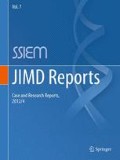Abstract
The X-chromosomal-linked lysosomal storage disorder Fabry disease can lead to life-threatening manifestations. The pathological significance of the Fabry mutation D313Y is doubted, because, in general, D313Y patients do not present clinical manifestations conformable with Fabry disease. This is in contrast to the analysis of the alpha-galactosidase A activity, which is reduced in D313Y patients. We report a comprehensive clinical, biochemical and molecular genetic analysis of two patients with a D313Y mutation. The alpha-galactosidase A activity was reduced in both patients. No Fabry symptoms or Fabry organ involvement was detected in these patients. The new biomarker lyso-Gb3, severely increased in classical Fabry patients, was determined and in both patients lyso-Gb3 was below the average of a normal population.
Our data for the first time not only clinically but also biochemically supports the hypothesis that the D313Y mutation is not a classical one, but a rare variant mutation.
Competing interests: none declared
Authors Markus Niemann and Arndt Rolfs contributed equally
Access this chapter
Tax calculation will be finalised at checkout
Purchases are for personal use only
References
Aerts JM, Groener JE, Kuiper S et al (2008) Elevated globotriaosylsphingosine is a hallmark of Fabry disease. Proc Natl Acad Sci USA 105:2812–2817
Auray-Blais C, Ntwari A, Clarke JT et al (2010) How well does urinary lyso-Gb3 function as a biomarker in Fabry disease? Clinica chimica acta; Int J Clin Chem 411:1906–1914
Baptista MV, Ferreira S, Pinho EMT et al (2010) Mutations of the GLA gene in young patients with stroke: the PORTYSTROKE study–screening genetic conditions in Portuguese young stroke patients. Stroke 41:431–436
Brakch N, Dormond O, Bekri S et al (2010) Evidence for a role of sphingosine-1 phosphate in cardiovascular remodelling in Fabry disease. Eur Heart J 31:67–76
Desnick R, Ionnou Y, Eng C (1995) Fabry disease: alpha galactosidase A deficiency. In: Scriver C, Beaudet A, Sly W, Valle D (eds) The metabolic and molecular bases of inherited disease. McGraw Hill, New York, pp 2741–2784
Eng CM, Resnick-Silverman LA, Niehaus DJ, Astrin KH, Desnick RJ (1993) Nature and frequency of mutations in the alpha-galactosidase A gene that cause Fabry disease. Am J Hum Genet 53:1186–1197
Froissart R, Guffon N, Vanier MT, Desnick RJ, Maire I (2003) Fabry disease: D313Y is an alpha-galactosidase A sequence variant that causes pseudodeficient activity in plasma. Mol Genet Metab 80:307–314
Gaspar P, Herrera J, Rodrigues D et al (2010) Frequency of Fabry disease in male and female haemodialysis patients in Spain. BMC Med Genet 11:19
Havndrup O, Christiansen M, Stoevring B et al (2010) Fabry disease mimicking hypertrophic cardiomyopathy: genetic screening needed for establishing the diagnosis in women. Eur J Heart Fail 12:535–540
Houge G, Tondel C, Kaarboe O, Hirth A, Bostad L, Svarstad E (2011) Fabry or not Fabry–a question of ascertainment. Eur J Human Genetics: EJHG 19:1111
Linthorst GE, Bouwman MG, Wijburg FA, Aerts JM, Poorthuis BJ, Hollak CE (2010) Screening for Fabry disease in high-risk populations: a systematic review. J Med Genet 47:217–222
Schiffmann R (2009) Fabry disease. Pharmacol Ther 122:65–77
Tanislav C, Kaps M, Rolfs A et al (2011) Frequency of Fabry disease in patients with small-fibre neuropathy of unknown aetiology: a pilot study. Eur J Neurol 18:631–636
van Breemen MJ, Rombach SM, Dekker N et al (2011) Reduction of elevated plasma globotriaosylsphingosine in patients with classic Fabry disease following enzyme replacement therapy. Biochim Biophys Acta 1812:70–76
Weidemann F, Niemann M (2010) Screening for Fabry disease using genetic testing. Eur J Heart Fail 12:530–531
Whybra C, Miebach E, Mengel E et al (2009) A 4-year study of the efficacy and tolerability of enzyme replacement therapy with agalsidase alfa in 36 women with Fabry disease. Genet Med 11:441–449
Wozniak MA, Kittner SJ, Tuhrim S et al (2010) Frequency of unrecognized Fabry disease among young European-American and African-American men with first ischemic stroke. Stroke 41:78–81
Yasuda M, Shabbeer J, Benson SD, Maire I, Burnett RM, Desnick RJ (2003) Fabry disease: characterization of alpha-galactosidase A double mutations and the D313Y plasma enzyme pseudodeficiency allele. Hum Mutat 22:486–492
Author information
Authors and Affiliations
Corresponding author
Editor information
Editors and Affiliations
Additional information
Communicated by: Frits Wijburg
Appendices
Take Home Message
Our Lyso-Gb3 analysis indicates that the alpha-galactosidase A mutation D313Y is not clinically relevant for Fabry disease and questions the usual way to diagnose Fabry disease.
Conflict of Interest
None declared.
Rights and permissions
Copyright information
© 2012 SSIEM and Springer-Verlag Berlin Heidelberg
About this chapter
Cite this chapter
Niemann, M. et al. (2012). Lyso-Gb3 Indicates that the Alpha-Galactosidase A Mutation D313Y is not Clinically Relevant for Fabry Disease. In: Brown, G., Morava, E., Peters, V., Gibson, K., Zschocke, J. (eds) JIMD Reports - Case and Research Reports, 2012/4. JIMD Reports, vol 7. Springer, Berlin, Heidelberg. https://doi.org/10.1007/8904_2012_154
Download citation
DOI: https://doi.org/10.1007/8904_2012_154
Received:
Revised:
Accepted:
Published:
Publisher Name: Springer, Berlin, Heidelberg
Print ISBN: 978-3-642-32441-3
Online ISBN: 978-3-642-32442-0
eBook Packages: MedicineMedicine (R0)

